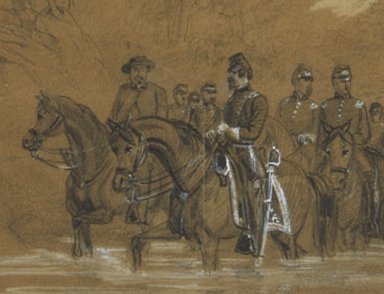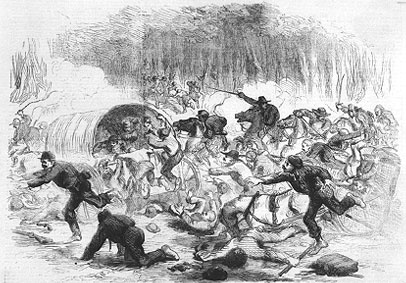Combat artist Frank Vizetelly
18 March 2007
I’ve been chastened to find General JEB Stuart had a more considerable role at Sharpsburg on 17 September 1862 than I’ve long thought. He was apparently “everywhere” on the field, noticed particularly in directing the Confederate far left flank. His greatest service may have been in placing and leading the artillery on Nicodemus Heights and later on Hauser’s Ridge. A case can easily be made that he and those gunners saved the day for General Lee at Sharpsburg.
But I’ll save that larger story for another day. Today I’m following threads inspired by this illustration of Stuart:
The artist was Frank Vizetelly (1830 – c.1883) of the Illustrated London News. This scene was published in the 4 November 1862 edition, and suggests Vizetelly sketched the General about the time of the Antietam Campaign. I can’t verify that Vizetelly was in Maryland, though. Judging by his sketch history, he’d been “west” until at least July 1862, and can’t be positively placed with the Army of Northern Virginia til October.
In any event, Frank Vizetelly did some superb work during the War, and he’s certainly worthy of further examination …
The artist was born in London, studied art and lived in France, and had covered combat with Garibaldi in Sicily and Italy before being assigned by the News to America in 1861. Here’s an 1861 sketch of Federal General Sickles with Vizetelly (left) done by fellow “special artist” and brother Englishman Alfred Waud.


Sickles and staff on reconaissance (Waud, 1861)
Clearly Vizetelly had good access, as we’d say today.
Both artists were with the Federal Army at the battle of First Bull Run in July 1861, where Vizetelly produced this image of the retreat:

Retreat from Bull Run (Vizetelly, 1861)
There went his access. The word is that Secretary of War Stanton was so “incensed” by the unflattering portrayal that he denied Vizetelly any further Army contact. From that point, until returning to England at the end of the War, Frank Vizetelly travelled with Confederate forces. He was an open admirer of the Confederacy, and took an active part on campaign, at least once serving as courier to Stuart in battle.
Over the duration he sent more than 100 drawings to London. Many, however, were intercepted by the Federal blockade and ended up in Northern sheets like Harper’s and Leslie’s. Sadly, very few of his original sketches survive. The Nazis destroyed most of them bombing London during World War Two. The few that remain are in a collection at Harvard University.
A particularly nice survivor, which includes JEB Stuart again, is this one from late 1862:


Genl Stuart’s Head Quarters, Advanced Post of the Confederate Army in Northern Virginia (Vizetelly, Oct-Nov 1862)
Typical of Vizetelly and a handfull of other combat artists, this original sketch shows a fine eye and deft touch – usually destroyed (witness the Stuart picture at top) when translated by engravers at the newpaper onto woodblocks for rendering in print. This sketch also begins another thread–one with some considerable research potential, mind you–with which I’ll only tease.
The picture is described in notes as:
A scene in the camp of Jeb Stuart showing group of men around campfire. In foreground showing Stuart, General Norman Fitzhugh, and other staff members. Also shows tent-quarters of General Stuart
Thanks to g-g-grandson Michael S. Martin, I learned that the man identified as General Fitzhugh was actually a Major. Close students of General Stuart’s adventures in August 1862 may recognize Fitzhugh’s name.
After the Seven Days (June 1862), Stuart noted in his Official Report:
Capt. Norman R. Fitzhugh, assistant adjutant-general, chief of staff, though but recently promoted from the ranks, gave evidence of those rare qualities, united with personal gallantry, which constitute a capable and efficient adjutant-general.
Douglas Southall Freeman, in R. E. Lee: A Biography, relates events:
As day was breaking on the 18th [August 1862] Stuart saw a body of horsemen some 400 yards away and heard the clatter of advancing hoofs and the groaning of wheels. He asked Captain Mosby and Lieutenant Gibson to inquire if the column was Fitz Lee’s. There was a moment’s wait, loud voices, a shout of “Yankee cavalry,” a few nervous shots, and in an instant more Stuart was up, mounted, over a fence and dashing for the nearby woods, while his aides were scattered and galloping off with a Federal patrol in avid pursuit. Fortunately, all the staff escaped except Major Fitzhugh, who had been captured while looking vainly for Fitz Lee, and had been an unhappy spectator of his chief’s hurried flight.
A local tour guide picks up the story:
… Stuart lost his ostrich-plumed hat, but a week later turned the tables by capturing General Pope’s tent and personal effects. […] When Fitzhugh was captured during the night he was carrying a copy of the Confederate plan of campaign. Because of the information then obtained, Pope withdrew across the Rappahannock River and thereby postponed his defeat by a week.
There’s far more to the Major, surely, as he lived to 1915, but I’ll leave that to others. Frank Vizetelly, however, did not enjoy the same longevity.
After sticking with President Jefferson Davis to the bitter end in 1865, he returned to England, next covering combat for his paper in Spain in 1868. He was last heard from in the company of unfortunate British and Egyptian troops annihilated in the Sudan at the “massacre at Kashgil” in 1883 during the Mahadist War.

F. Vizetelly (Brady studios, c. 1861)
A fitting end, I would think, for an inveterate combat artist.
___________________
Notes
The first illustration, above, is from the Illustrated London News (ILN) of November 4, 1862 as reproduced in company with REL Krick’s essay Defending Lee’s Flank in The Antietam Campaign (U of NC Press, 1999); Gary W Gallagher, editor.
The Alfred Waud drawing of Sickles and Vizetelly is from the Library of Congress and the copy of the Bull Run picture used here is from the History Matters website from GMU. It was originally published in the ILN on 17 August 1861.
The Stuart and Fitzhugh sketch is from the Harvard collection and posted online by g-g-grandson M.S. Martin on his Martin House site. Very nicely done.
The photograph of Frank Vizetelly is a “Brady”, also from the collection of the Library of Congress, and is likely to have been taken prior to Bull Run.
Biographical information about Vizetelly and his career come from AskArt online, the GMU Library, and a reference from Time Magazine in Artist-Journalists of the Civil War, Friday, 17 February 1961. Volume 2, Chapter 21 of Freeman’s Lee biography, quoted above, is online from the University of Chicago.



June 19th, 2010 at 12:06 am
My interest in Frank Vizetelly goes back several years and includes many hours of library research. Two anecdotes about Vizetelly may amuse you. He told his brother who related it in his biography that he had crossed the Potomac on a raft, accompanied by a black man who dived for oysters to feed them both as the hid from Union patrol craft.
His brother also relates the story that when Frank accompanied the army sent to suppress the Mahdi rebels, he did so on foot, being too poor to hire a horse or camel. Apparently, by then he was freelance or had already
” consumed” his retainer!
One further story: the expedition into the Sudan was annihilated by the Mahdi’s forces and the British War Office decided to mount a more substantial invasion. As it was being planned, Frank’s brother wrote to the then Garnet Wolseley who was leading the expedition telling him that Frank was missing and asking if he could find out what happened to him. He remind Wolseley that he and Frank had shared a tent in Virginia during the American Civil War and that Frank had “lent him a pair of socks”! I could find no trace of an answer from Wolseley. Poor Frank. He may have ended his days as a white slave.
March 5th, 2011 at 12:06 am
[…] British sympathisers who fought on either side in this conflict or journalists such as Frank Vizetelly, a reporter who drew startling pictures for the Illustrated London News and seemed never to miss a […]